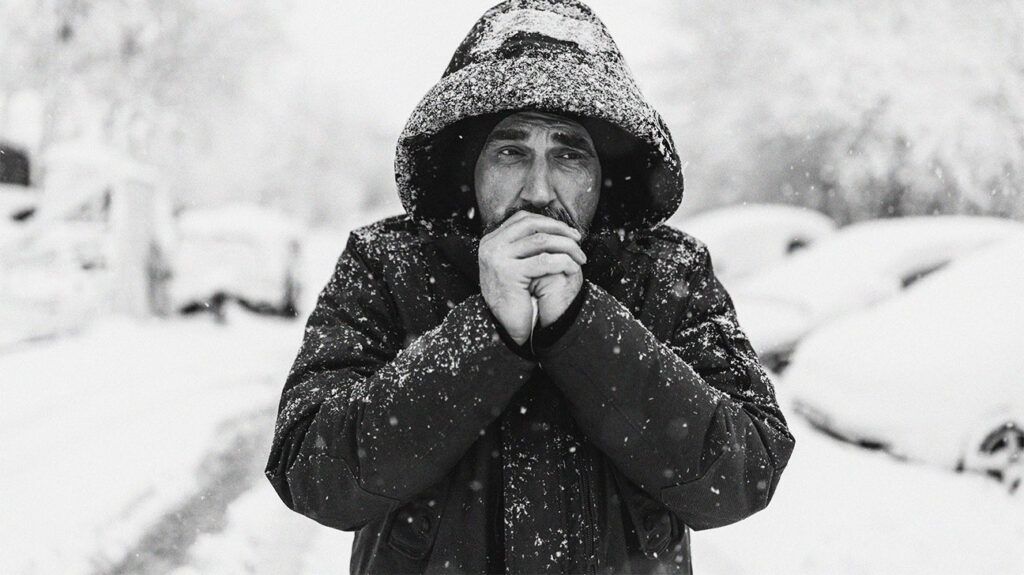People living with chronic obstructive pulmonary disease (COPD) may find that cold weather worsens their symptoms. This can lead to shortness of breath and coughing more than usual.
“COPD” is an umbrella term for a group of progressive lung diseases that can cause a person to experience airflow blockages and breathing difficulties.
Symptoms of COPD may include fatigue, wheezing, coughing, and shortness of breath. Cold weather may cause these symptoms to flare up or worsen.
In this article, we explore the impact of cold weather on COPD and offer tips for managing the condition in colder temperatures.

COPD is an umbrella term for bronchitis and emphysema. These conditions typically develop as a result of long-term exposure to irritants, such as chemicals and tobacco smoke, which damage the lungs and airways.
Although cold weather does not cause COPD, it can affect COPD symptoms. This may be because this type of weather can cause a person’s mouth and airways to become narrow, irritated, and dry. Ultimately, this can worsen or trigger symptoms in people living with COPD.
A 2022 study suggests that cold temperatures can trigger phlegm and cough symptoms in people living with COPD.
Cold weather can worsen existing respiratory conditions, including COPD.
Cold air, in particular, can affect a person’s lungs and health. Often, this type of air is dry, which can irritate the airways of people living with preexisting lung diseases. This can lead to coughing, wheezing, and shortness of breath.
Among those living with respiratory conditions, exposure to cold temperatures can exacerbate symptoms within a
Moreover, during periods of cold weather, common respiratory viruses such as the flu can
Cold weather can pose challenges for individuals with COPD. However, it does not mean that individuals with COPD or other lung conditions should avoid going outside altogether.
Outdoor activities are crucial for maintaining overall health and well-being. However, it is essential to take precautions to minimize the impact of cold weather on respiratory symptoms.
A person living with COPD may consider the following tips to stay warm when outside during cold temperatures:
- Layering: Dressing in layers helps trap warm air close to the body. This includes wearing a thermal base layer, insulating layers, and a windproof outer layer.
- Wearing accessories: Wearing a warm hat, gloves, and scarf can help keep the head, hands, and neck warm.
- Putting a scarf or mask over the mouth and nose: Covering the face and mouth with a scarf or mask can help humidify and warm the air before it reaches the lungs.
- Practicing breathing techniques: Breathing through the nose instead of the mouth can help warm the air a person is breathing.
- Keeping moving: When outside, keep moving, as this will generate heat and help a person feel warmer.
As well as staying warm while outside, a person living with COPD can also take steps to stay warm while indoors. Some examples of staying warm while inside include:
- Maintaining indoor warmth: Keep the indoor environment at a comfortable temperature to prevent the onset of symptoms. Proper insulation and heating are crucial, especially during colder months.
- Using a humidifier: Adding moisture to the air can prevent it from becoming too dry, reducing the risk of irritation to the respiratory tract.
- Wearing warm clothing indoors: Dressing warmly, even when inside, can help individuals with COPD stay comfortable and reduce the strain on their respiratory system.
- Using warm bedding: Consider using extra bedcovers or a heated blanket to help stay warm during the night.
- Closing windows and drawing curtains: This can help insulate a room, keeping heat in and cold out.
Other tips for managing COPD and maintaining lung health can include:
- Getting regular exercise: Regular physical activity can improve lung function and overall health. Consult with a healthcare professional to determine suitable exercise routines.
- Managing medications: Adhering to prescribed medication regimens is crucial for managing COPD symptoms. Discuss any concerns or adjustments needed during colder months with a healthcare professional.
- Getting flu vaccines: Healthcare professionals recommend annual flu vaccinations for individuals with COPD to reduce the risk of respiratory infections, which can exacerbate symptoms, especially in colder seasons.
- Avoiding triggers: Common triggers that can exacerbate COPD symptoms include smoke, strong odors, pollen, chemicals, and fumes.
- Practicing deep breathing: Engaging in “belly breathing” or “pursed lip breathing” can help alleviate sensations of shortness of breath.
While cold weather can potentially exacerbate COPD symptoms, it should not deter individuals from maintaining an active lifestyle in the outdoors.
With proper precautions, such as dressing warmly, protecting the airways, and following medical advice, individuals with COPD can navigate the challenges posed by cold weather.
